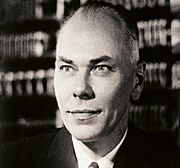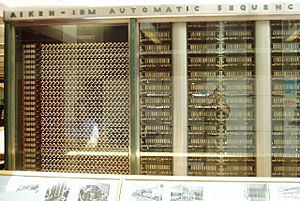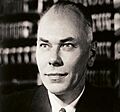Howard H. Aiken facts for kids
Quick facts for kids
Howard Hathaway Aiken
|
|
|---|---|

Howard Aiken
|
|
| Born | March 8, 1900 |
| Died | March 14, 1973 (aged 73) |
| Nationality | American |
| Alma mater | University of Wisconsin–Madison Harvard University (doctorate) |
| Known for | Automatic Sequence Controlled Calculators Harvard Mark I – IV |
| Spouse(s) |
|
| Awards | Harry H. Goode Memorial Award (1964) Edison Medal (1970) |
| Scientific career | |
| Fields | Applied mathematics, computer science |
| Institutions | Harvard University |
| Doctoral advisor | Emory Leon Chaffee |
| Doctoral students | Gerrit Blaauw Fred Brooks Kenneth E. Iverson Anthony Oettinger Gerard Salton |

Howard Hathaway Aiken (born March 8, 1900 – died March 14, 1973) was an American physicist. He was a very important pioneer in the world of computers. He is known for being the main designer of the IBM Harvard Mark I computer.
Contents
Howard Aiken's Life and Work
Aiken studied at the University of Wisconsin–Madison. He later earned his Ph.D. in physics from Harvard University in 1939. During his studies, he faced differential equations. These were math problems he could only solve by doing many calculations by hand.
Creating the Harvard Mark I
Aiken was inspired by Charles Babbage's difference engine. He imagined a machine that could do these long calculations automatically. This machine was first called the ASCC. That stood for Automatic Sequence Controlled Calculator. Later, it was renamed the Harvard Mark I.
IBM helped with the engineering, building, and funding for the machine. It was finished and set up at Harvard in February 1944. Richard Milton Bloch, Robert Campbell, and Grace Hopper later joined the project. They helped program the new computer.
Developing More Computers
In 1947, Aiken finished his work on the Harvard Mark II computer. He then continued to work on the Mark III and the Harvard Mark IV. The Mark III used some electronic parts. The Mark IV was fully electronic. Both the Mark III and Mark IV used magnetic drum memory. The Mark IV also had magnetic core memory.
Contributions to Computer Education
Besides building the Mark series computers, Aiken made another big contribution. In 1947, he started a master's program for computer science at Harvard. This was almost ten years before other universities began similar programs. This program became a starting point for many future computer scientists. Many of them completed their advanced degrees under Aiken's guidance.
Awards and Recognition
Howard Aiken received many special honors. He was given honorary degrees from several universities. In 1947, he was chosen as a Fellow of the American Academy of Arts and Sciences. He also received important awards for his work. These included the Harry H. Goode Memorial Award in 1964. In 1970, he received the IEEE Edison Medal. This award recognized his important work in developing large digital computers. It also honored his contributions to teaching about computers.
Howard Aiken's Personal Life
Howard Aiken was married three times. He had two daughters. His first wife was Louise Mancill. His second wife was Agnes Montgomery. His last wife was Mary McFarland.
Aiken also served in the United States Navy Reserve. He was a Commander.
Later Years and Legacy
After retiring at age 60, Aiken moved to Fort Lauderdale, Florida. He continued to contribute to technology. He started a company called Howard Aiken Industries Incorporated. This company was a consulting firm. It helped businesses that were struggling to get back on track.
During his years in Florida, he joined the University of Miami. He worked there as a Distinguished Professor of Information. Aiken also became a consultant for big companies. These included Lockheed Martin and Monsanto.
Howard Aiken passed away on March 14, 1973. He died during a consulting trip to St. Louis, Missouri. His wife, Mary, passed away in 2013.
Images for kids
See also
 In Spanish: Howard H. Aiken para niños
In Spanish: Howard H. Aiken para niños



